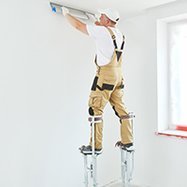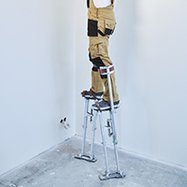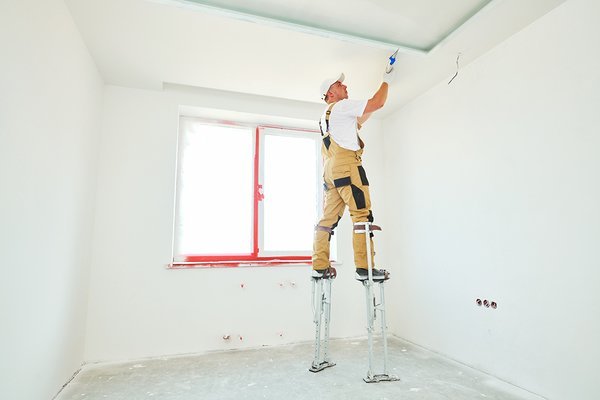BestReviews is reader-supported and may earn an affiliate commission. Details

A set of durable drywall braces that weigh about 15 pounds.
A set of durable drywall braces that weigh about 15 pounds.
Adjustable without tools between 18 and 30 inches high. Has 6 buckles and 2 knee guards. Made of strong but lightweight aluminum. Has a 225-pound weight limit. Has flexible springs for better movement. The base prevents floor scratches.
May not stand as sturdy as some other options.

A brightly colored pair of aluminum drywall stilts that can add 18 to 30 inches to your height.
A brightly colored pair of aluminum drywall stilts that can add 18 to 30 inches to your height.
Has a 228-pound load capacity. If you need to make adjustments, the customizable heel plates and foot straps are convenient and easy to use. The lightweight aluminum design makes these stilts easier to use for extended periods of time.
The straps on this model have a tendency to loosen a little while you're working.

This is a mid-range choice for those working on smaller drywall and painting projects at home.
This is a mid-range choice for those working on smaller drywall and painting projects at home.
High-grade aluminum frame. Dual-action springs mimic natural walking. Rated load capacity of 225 pounds. Height adjustment with no tools required. Customizable sizing for braces to suit any user. Auto-locking buckles and calf pads. Non-marring sole material protects floors.
Height capacity is limited to a maximum extension of 23 inches.

These drywall stilts are designed for use in a workplace with a higher ceiling.
These drywall stilts are designed for use in a workplace with a higher ceiling.
At a maximum height, these drywall stilts can add 64 inches to your reach. They can hold up to 225 pounds and have dual-action springs for flexibility. The 3-position heel brackets securely accommodate a variety of shoe sizes.
Since these stilts are rather tall, it can take a few practice sessions before you feel comfortable in them.

These sleek drywall stilts come from high-quality aluminum alloy, with a sturdy design that simplifies walking.
These sleek drywall stilts come from high-quality aluminum alloy, with a sturdy design that simplifies walking.
They're great for DIY projects around the house, but double as amazing props for cosplayers. The rubber souls won't leave scratches on the floor below, and the dual-action springs make walking feel more natural. You can adjust the heel bracket to fit 3e different stances.
Taller people may find the minimum height too high.

We recommend these products based on an intensive research process that's designed to cut through the noise and find the top products in this space. Guided by experts, we spend hours looking into the factors that matter, to bring you these selections.


If you want to give the crown molding in your home a fresh coat of paint, it would be difficult to do from the floor. Even with a step ladder, you’d need to climb down to reposition the ladder and climb back up to start painting again, which just compounds the chances for falling and injury. A quality pair of drywall stilts is the solution when it comes to painting ceilings and many home repairs.
Drywall stilts typically add anywhere from 18 to 40 inches to your reach without the use of a ladder. These handy devices can be used for simple tasks like changing a lightbulb and painting to heavy-duty chores like hanging suspended ceiling tiles. The best models are secure, comfortable, adjustable, and able to support the full weight of both you and your tools.


The two critical elements you need to consider when purchasing drywall stilts are height and weight capacity.
The right height needed for drywall stilts varies depending not only on the project but also the size of the individual. Luckily, most drywall stilts extend around 18 inches from the lowest height setting to the highest. You don’t want to purchase stilts that are too short because that means you'd still have to stretch to accomplish the task, only now you're doing it on stilts! Think about your ideal height for the task at hand and choose the model that can elevate you to that height. If you do this kind of work for a living, consider purchasing two pairs of stilts of different sizes so you’ll always be prepared.
The load-bearing capacity of drywall stilts typically tops out at about 230 pounds. Since that’s per stilt, some believe a pair can support well over 400 pounds. This would be the case if the load was equally distributed over both stilts and it never moved. However, the instant you pick up one foot, the stilt that’s still on the ground is bearing the full load. If that load is more than the stated weight capacity, the stilt may fail. Look for a model that can safely support your weight plus the weight of your tools and any construction materials you may be carrying.


Feet: The larger the feet on your drywall stilts, the easier it is to maintain your balance. The best models have two support beams running from the footplate to the stilt foot so it can provide better support and offer a slightly more natural flex in the step. It’s important to have nonslip, non-marring rubber feet on the drywall stilts to keep them from sliding out from under you or damaging the floor when you’re walking.
Footplates: Your feet rest on these when wearing the drywall stilts. They need to be large enough to accommodate your shoe size. Adjustable heel plates are also highly recommended because they hold your heel in place.
Locking straps: The straps that go around your shoes need to lock in place so they won’t loosen while you’re working. Some of the high-end models feature a ratcheting system to make sure your feet are securely fastened to the stilts.
Calf supports: When wearing drywall stilts, your calves are the most prone to discomfort or chafing. The best calf supports are cushioned, with a strap that fully wraps around your leg to hold it in place. You also want calf supports that somewhat curve around your calves to help cradle them in place.
Drywall stilts need to be adjustable so you can customize them to the task at hand. However, if you need an arsenal of tools to change the height of your stilts a few inches, you may opt to work at an uncomfortable level rather than make the adjustment. Tool-free adjustments that can be fully secured with ease are the best.
A pair of drywall stilts needs to be lightweight, durable, and corrosion-resistant. Even though aluminum alloy isn’t quite as tough as steel, it’s preferred because of its lighter weight. Every time you take a step, you need to lift the stilt off the ground. Toward the end of the day, when you’re getting tired, a heavier stilt increases your chances of tripping and falling.
When taking those first few steps on drywall stilts, it helps to have someone on either side of you for balance and confidence.
Inexpensive: Drywall stilts start at around $100. Although it's not a hard and fast rule, in general, these models offer a height boost of about 18 to 30 inches. These drywall stilts might not provide a great deal of comfort or have much more than the most basic safety features, but they’re probably good enough for someone who needs a pair for occasional use.
Mid-range: From around $150 to $200, drywall stilts tend to give the user a little more height, usually 24 to 40 inches. These models also tend to include locking safety features and additional padding and support around the calves. The average user can expect to spend this much.
Expensive: Unless you’re going to be using your drywall stilts on a regular basis, you probably don’t need to spend $250 or more. Although these models may offer extra height or be reinforced to support more weight, the drywall stilts in the middle price range will likely be of greater value to the average homeowner.




A. At the time of writing, OSHA does not prohibit the use of drywall stilts. In California, however, stilts are specifically named and prohibited by Cal-OSHA (Article 21: Scaffolds: General Requirements). In Canada, you may be required to take a course before using drywall stilts. Additionally, the use of drywall stilts might require workplace modifications such as raised guardrails. Be sure to research the region where you’ll be working to make sure you aren’t unintentionally violating any safety codes.
A. Hearing the words "drywall stilts," most people might think of a balancing act in the circus. Fortunately, modern drywall stilts are not quite so dangerous. Drywall stilts have a large footprint, making them easy for most people to use rather quickly. This is not to say that drywall stilts are free of risk. They can contribute to serious injury if used improperly or carelessly.
A. The biggest benefit is convenience. You don’t need to keep climbing up and down a ladder on a job site when using drywall stilts, so it can make the workflow more smoothly. Also, even though they may look more dangerous than a ladder, drywall stilts can offer greater stability and comfort whether you’re moving or standing still. The best reason for using drywall stilts, however, is to keep you from reaching. Overextending is one of the biggest reasons for back and other workplace-related injuries.
Get emails you’ll love.
Learn about the products you’re wondering if you should buy and get advice on using your latest purchases.
